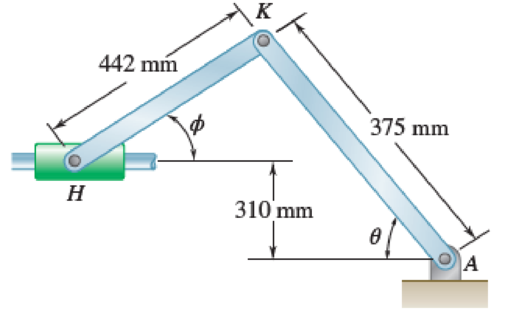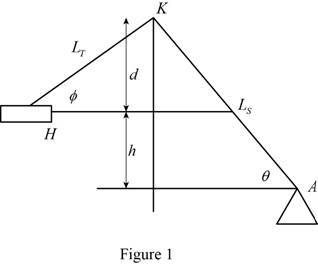
Concept explainers
The right leg of an athlete on a rowing machine can be modeled as a linkage as shown, where A represents the ankle (which is stationary), K the knee, and H the hip. At the instant when θ = 75°, the shank AK has an angular velocity of 1 rad/s and an angular acceleration of 1.5 rad/s2, both counterclockwise. Determine the velocity and acceleration of the hip H at this instant in time.

Fig. P15.123
Find the velocity and acceleration of the hip H at the instant.
Answer to Problem 15.123P
The velocity and acceleration of the hip H are
Explanation of Solution
Given information:
The ankle, knee and the hip are denoted by A, K, and H.
The ankle A is stationary.
The value of the angle is
The angular velocity of the shank AK is
The angular acceleration of the shank AK is
Calculation:
Show the modelled linkage as shown in Figure 1.

Refer to Figure 1.
Consider the distance KH and KA are denoted by
Show the relation between the distances KH and KA as follows:
Modify Equation (1) using Equation (2).
Substitute
Show the relative velocity for AK as follows:
Show the relative velocity for KH as follows:
Consider the position of the point K with respect to A is denoted by
Consider the position of the point H with respect to K is denoted by
Substitute
Equate the j component of the Equation (4).
Substitute
Equate i component of the Equation (4).
Substitute
Thus, the velocity at H is
Consider AK.
Show the relation between the acceleration of A and K as follows:
Substitute
Consider HK.
Show the relation between the acceleration of H and K as follows:
Substitute
Equate j component of the Equation (7).
Substitute
Equate i component of the Equation (7).
Substitute
Thus, the acceleration at H is
Want to see more full solutions like this?
Chapter 15 Solutions
VECTOR MECHANICS FOR ENGINEERS W/CON >B
Additional Engineering Textbook Solutions
Vector Mechanics for Engineers: Statics and Dynamics
Mechanics of Materials (10th Edition)
Fluid Mechanics: Fundamentals and Applications
Database Concepts (8th Edition)
Electric Circuits. (11th Edition)
Java: An Introduction to Problem Solving and Programming (8th Edition)
- A piston–cylinder device contains 3 kg of nitrogen initially at 100 kPa and 25°C. Nitrogen is now compressed slowly in a polytropic process during which PV1.3 = constant until the volume is reduced by one-half. Determine the work done and the heat transfer for this process. The gas constant of N2 is R = 0.2968 kPa·m3/kg·K. The cv value of N2 at the anticipated average temperature of 350 K is 0.744 kJ/kg·K (Table A-2b). The work done for this process is kJ. The heat transfer for this process is kJ.arrow_forwardA 4-m × 5-m × 6-m room is to be heated by a baseboard resistance heater. It is desired that the resistance heater be able to raise the air temperature in the room from 5 to 25°C within 10 min. Assuming no heat losses from the room and an atmospheric pressure of 100 kPa, determine the required power of the resistance heater. Assume constant specific heats at room temperature. The properties of air are R = 0.287 kJ/kg·K and cv = 0.718 kJ/kg·K (Table A-2a). The required power of the resistance heater is kW.arrow_forwardI need solve without AI and chatgptarrow_forward
- An ordinary egg can be approximated as a 5.5-cm-diameter sphere. The egg is initially at a uniform temperature of 8°C and is dropped into boiling water at 97°C. Taking the properties of the egg to be ρ = 1020 kg/m3 and cp = 3.32 kJ/kg·°C, determine how much heat is transferred to the egg by the time the average temperature of the egg rises to 82°C. The heat transferred to the egg in this case is kJ.arrow_forwardShip construction question. Sketch and describe the forward arrangements of a ship. Include componets of the structure and a explanation of each part/ term.arrow_forwardI don't want an AI solution please.arrow_forward
- 42 PART 1 Introduction A. E. I constant FIGURE 1.22 A fixed-pinned beam. 1.6 Find the stress distribution in the beam shown in Fig. 1.22 using two beam elements.arrow_forward1.4 Using a one-beam element idealization, find the stress distribution under a load of P for the uniform cantilever beam shown in Fig. 1.20. A, E, I constant L FIGURE 1.20 A uniform cantilever beamarrow_forwardMechanical engineering,FBD required.arrow_forward
 Elements Of ElectromagneticsMechanical EngineeringISBN:9780190698614Author:Sadiku, Matthew N. O.Publisher:Oxford University Press
Elements Of ElectromagneticsMechanical EngineeringISBN:9780190698614Author:Sadiku, Matthew N. O.Publisher:Oxford University Press Mechanics of Materials (10th Edition)Mechanical EngineeringISBN:9780134319650Author:Russell C. HibbelerPublisher:PEARSON
Mechanics of Materials (10th Edition)Mechanical EngineeringISBN:9780134319650Author:Russell C. HibbelerPublisher:PEARSON Thermodynamics: An Engineering ApproachMechanical EngineeringISBN:9781259822674Author:Yunus A. Cengel Dr., Michael A. BolesPublisher:McGraw-Hill Education
Thermodynamics: An Engineering ApproachMechanical EngineeringISBN:9781259822674Author:Yunus A. Cengel Dr., Michael A. BolesPublisher:McGraw-Hill Education Control Systems EngineeringMechanical EngineeringISBN:9781118170519Author:Norman S. NisePublisher:WILEY
Control Systems EngineeringMechanical EngineeringISBN:9781118170519Author:Norman S. NisePublisher:WILEY Mechanics of Materials (MindTap Course List)Mechanical EngineeringISBN:9781337093347Author:Barry J. Goodno, James M. GerePublisher:Cengage Learning
Mechanics of Materials (MindTap Course List)Mechanical EngineeringISBN:9781337093347Author:Barry J. Goodno, James M. GerePublisher:Cengage Learning Engineering Mechanics: StaticsMechanical EngineeringISBN:9781118807330Author:James L. Meriam, L. G. Kraige, J. N. BoltonPublisher:WILEY
Engineering Mechanics: StaticsMechanical EngineeringISBN:9781118807330Author:James L. Meriam, L. G. Kraige, J. N. BoltonPublisher:WILEY





